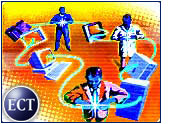
Around this time last summer, my mother made her Christmas shopping list. It’s a tradition for her to start early. The general idea is to avoid the crowds, traffic and general madness of seasonal shopping.
I suggested she shop online. I gave her the usual litany of benefits — she could shop from the sofa, avoid the lines, be done in an evening or two. Besides, I informed her smugly, most online merchants will gift wrap for her. What could be easier?
Of course, you’re familiar with the objections. She wanted to touch items before she bought them, especially clothes. She was nervous about giving out her credit-card number. “I can’t imagine ever being comfortable shopping that way,” she assured me.
Weeks passed, then months, and she was too busy to go to any actual brick-and-mortar stores. And then it happened. Just after Thanksgiving, after a quick pep talk from me, she went to Amazon and discovered Wish Lists. A few clicks later, and she was knocking out that Christmas list. Now she has a new tradition.
Give In and Dial Up
According to new research by Forrester, Mom’s first-time shopping excursion is an increasingly common phenomenon. Despite protests, more and more non-wired folks — even those who swore they’d never succumb to the charms of the Net — are logging on for the first time.
At a time when few companies have good news to report, could this be a light at the end of the tunnel?
The study followed people who rated themselves unlikely to ever go online. A year later, 30 percent of those households were wired. To sweeten the news, 80 percent of consumers who rated themselves “extremely likely” to go online within six months followed through with their plans. Based on these results, Forrester predicts the Net’s overall penetration will exceed 80 percent by 2006.
Take heart, struggling mass marketers. Chin up, Kmart and Wal-Mart. Your customer base will likely be looking for you online in the near future, regardless of what they say and do right now.
Buying Spree
Consumers who succumb to the lure of the Internet are also bringing their credit cards along for the ride.
When predicting future purchases, consumers were particularly accurate in certain product categories, such as books, software and music. In fact, 87 percent of those who judged themselves “likely” to purchase software online actually did so. Consumers calling themselves “not likely” made up the difference, at a rate of 20 percent.
Smart e-tailers will see those numbers as a sign that consumers are finally educated enough about e-commerce to predict their own spending patterns with reasonable accuracy. Most consumers know what they’ll be shopping for, and spend more than they expect. And to ice the cake, in come consumers who swore they wouldn’t buy a thing online, but then did.
Hard Road for Hardware
Forrester’s study showed less optimistic results for hardware vendors. Consumers who rated themselves “very likely” to buy a hardware, such as a PC or DVD, didn’t necessarily follow through. Only 21 percent of consumers bought the hardware product they were eyeing.
With the ease of many hardware manufacturer sites, the extensive comparison features, and the specials and promotions vendors have offered, this trend is harder to explain.
My guess? It’s the high-tech version of walking down the aisles and feeling the fabric. Consumers nervous about new hardware and confused about features may be schlepping to the local electronics store to find help from a real live person.
Edna’s Bandwagon
So why are consumers drawn so powerfully to the Net — even the ones who don’t intend to ever shop online?
Peer influence undoubtedly has an effect. Early adopters embracing e-commerce is hardly newsworthy on the grapevine, but when Aunt Edna takes the plunge, her peer group is watching — and listening. If she has a good experience, her more tentative friends might be persuaded to give it a try as well.
Offline advertising efforts must be having an effect on these consumers as well. Television ads, newspaper articles and promotions by brick-and-click retailers are slowly working their way into the minds of mass consumers.
Impulse Shopping
Where are the best opportunities for e-tailers? Consumers point to several product categories, such as books, music, software, electronics, flowers and airline tickets.
Bulk buying seasons (such as Christmas and back-to-school) and event-based buying groups (such as new dads and first-time homeowners) are ideal opportunities to lure first-time shoppers into e-tail stores.
They say if you build it, they will come. And here they come.
What do you think? Let’s talk about it.![]()
Note: The opinions expressed by our columnists are their own and do not necessarily reflect the views of the E-Commerce Times or its management.












































Social Media
See all Social Media